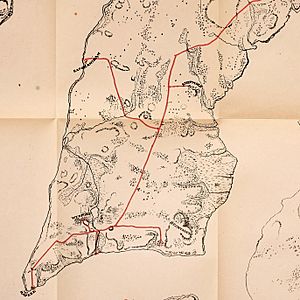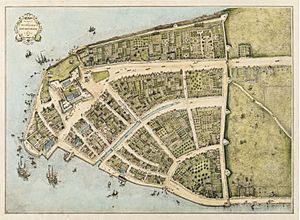Nechtanc facts for kids

Nechtanc was an important village for the Lenape people, a Native American group. Its name means "sandy point." This settlement was located in what is now the Two Bridges, Manhattan or Lower East Side area of New York City, right where the East River starts to curve north. In 1643, Nechtanc became known for a very sad event. Many Lenape people, mostly women and children, were killed there by order of the governor of New Netherland while they were sleeping. A similar event happened at Pavonia, just across the East River. Sometimes, old records call this village Rechtauk.
Contents
History of Nechtanc
Life Before Europeans Arrived
Nechtanc was a busy place for the Lenape people. They had a clear path leading to a large, deep pond, which we now call Collect Pond. This pond was a central spot for trading goods with other nearby Lenape villages.
The pond also fed fresh water into rivers and large marshy areas across Manhattan. The Lenape people were skilled at using canoes. These canoes were their main way to travel from their coastal village. They used them to paddle through the marshes to reach other parts of the island. They also traveled across the East River and even further away.
Other Lenape villages close to Nechtanc included Sapohanikan to the northwest and Konaande Kongh to the north. Nechtanc was also a favorite spot for fishing, providing food for the community.
Dutch Settlers Arrive
In the early 1600s, Dutch settlers began to build their own communities in the area. As more Europeans arrived, the Lenape people were slowly pushed out of their lands in Manhattan.
The first European to officially own the land where Nechtanc was located was Jacob van Corlear. He bought the land by 1639. This purchase was approved by the governor at the time, Wouter van Twiller. Corlear then rented the land to Willem Hendricksen for three years to start a farm. The Lenape village of Nechtanc continued to exist next to this farm for a few years. Dutch records from 1639 and 1640 mention the settlement by both names: Nechtanc and Nechttanck.
The Nechtanc Massacre

On the night of February 25, 1643, Nechtanc was the site of a terrible event. It was one of the first massacres of Native Americans by European colonists in North America. A large group of Lenape people from New Jersey had sought safety at Nechtanc and Pavonia. They were trying to escape conflict with the Mohicans to the north.
Around midnight, the governor, William Kieft, ordered that the Lenape people be killed while they slept. About 40 people were killed at Nechtanc. Another 80 were killed at Pavonia. Many of those who died were women and children. Some Dutch residents of New Amsterdam had disagreed with Governor Kieft's decision to start this attack.
After this massacre, the Dutch built a strong barrier between their settlement of New Amsterdam and the Lenape lands. This was meant to be a "buffer zone" in case the Lenape fought back, which they soon did in a conflict known as Kieft's War. This "buffer" area was given to freed slaves. The Dutch saw them as the most expendable part of their population.
Between the European settlement and this area, which the Dutch called "the negroes' farms," stood a 12-foot-high wall. It was made of sharpened oak posts and stretched for about 2,340 feet. The street that later ran along this wall became famous as Wall Street.
This massacre caused the Lenape people living near the lower Hudson River to unite in a way they never had before. They fought back against the Dutch. As noted by David Pietersz de Vries, a Dutch settler, the Lenape "burned all the houses, farms, barns, grain, haystacks, and destroyed everything they could get hold of." This started a destructive war. The Dutch feared more attacks from the Lenape for years after the massacre. This fear was one reason why Kieft was replaced as governor. His replacement, Peter Stuyvesant, later made the wall even stronger.

